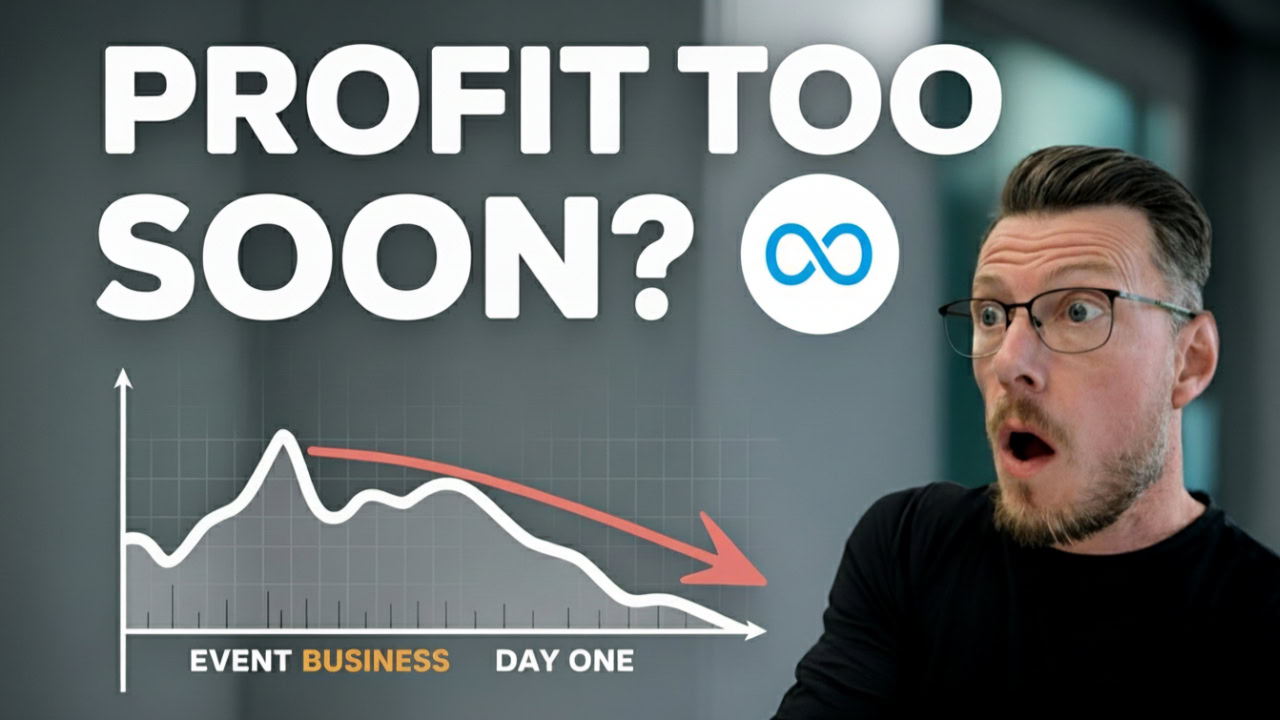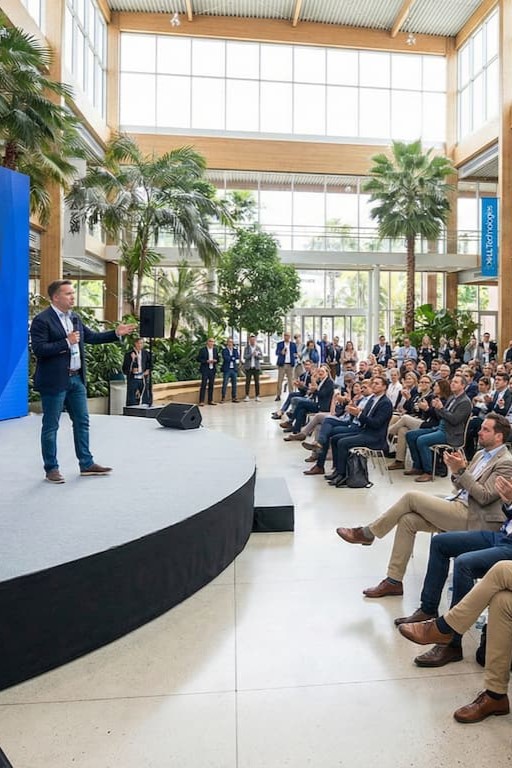Dan Charles
29/09/2025
Table of Contents

Most event businesses have their priorities completely backwards. They’ll spend months planning an event but mere weeks planning the marketing to fill it. It’s like training for a marathon by only running the week before the race.
This fundamental misunderstanding of marketing timelines is quietly bankrupting event agencies across the industry, creating devastating feast-or-famine cycles that keep otherwise talented professionals trapped in survival mode.
Key Takeaways
- Marketing timelines should be longer than event planning timelines, not shorter – if you’re planning December 2025 events, marketing should have started in June 2025
- The 4-6 month lag between marketing action and business impact means your quiet Q2 is directly caused by marketing gaps in Q1, not seasonal factors
- Evergreen marketing systems that address year-round customer pain points outperform seasonal campaigns by creating consistent lead flow regardless of traditional “peak” periods
- Digital-physical convergence is accelerating, requiring event businesses to think beyond individual events toward year-round relationship building
- Data-driven timeline planning using industry intelligence reveals patterns that individual businesses can’t see, enabling predictive rather than reactive marketing
The Seasonal Thinking Trap That’s Costing You Revenue
Event businesses fall into a dangerous trap: because their events are seasonal, they assume everything else should be seasonal too. This couldn’t be further from the truth.
Your customers don’t stop having problems during “off-season.” Their budget planning challenges, vendor management headaches, and ROI measurement difficulties persist year-round. Yet most event agencies only market when they’re desperate for bookings, completely missing the consistent demand for solutions to these permanent pain points.
According to industry research, event professionals spend an average of 8 weeks planning major corporate events, but only 3-4 weeks on marketing those same events. This backwards timeline creates predictable cash flow problems that plague the entire industry.
The Real Reason Your Revenue Is Unpredictable
The most painful part of feast-or-famine cycles isn’t the famine itself – it’s that businesses don’t understand what caused it. Through our work with dozens of event agencies and access to aggregate industry data via Google and Meta premier partnerships, we’ve identified the true culprit: the 4-6 month lag between marketing action and business impact.
When we overlay client revenue data with their marketing activity timelines, the pattern becomes crystal clear. That brutal Q2 revenue drop? It traces directly back to marketing gaps in Q1 when everyone was “too busy” to maintain consistent outreach.
One client recently shared their revelation: “I finally understood why my quiet periods were so predictable – I was creating them myself 6 months earlier by stopping marketing during busy seasons.”
This lag effect explains why reactive marketing – the industry standard – never works. By the time you realize you need leads, it’s too late to generate them through marketing. The damage was done months ago.
Building Marketing Systems That Work 365 Days a Year
The solution isn’t more marketing during quiet periods. It’s building evergreen marketing systems that never stop working, regardless of how busy you are with current projects.
Here’s hopw we help our clients build competitive “Moats” around their business through trend positioning.
1. Identify Year-Round Pain Points
Instead of promoting specific events, focus your marketing on the permanent challenges your ideal clients face:
- Budget allocation and planning stress
- Vendor coordination difficulties
- ROI measurement and reporting challenges
- Timeline management and logistics coordination
These problems don’t disappear during “off-season” – they intensify as businesses plan for the year ahead.
2. Create Evergreen Content Systems
Develop content that addresses these permanent pain points consistently throughout the year. One well-researched pain point can fuel 12 months of valuable content. The secret? Your audience gets bored of hearing your story long after you get bored of telling it.
3. Layer Seasonal Campaigns Over Evergreen Foundation
Rather than starting from zero each season, use your evergreen systems as the foundation and layer seasonal event promotion on top. This approach ensures you never lose momentum between events.
4. Implement Data-Driven Timeline Tracking
Track the correlation between marketing activities and business outcomes across multiple months, not just immediate responses. This reveals the true impact of consistent marketing versus reactive campaigns.
The Future of Event Marketing Is Already Here
The most successful event agencies are already adapting to what we call “bringing the event to you” – the convergence of digital and physical experiences that extends far beyond the event date itself.
This trend, accelerated by recent technological advances and changing buyer expectations, requires a fundamental shift in timeline thinking. Instead of marketing individual events, forward-thinking agencies market the entire relationship journey:
- Pre-event personalized content experiences
- Real-time hybrid participation options
- Extended post-event community engagement
- AI-driven personalization across all touchpoints
Event businesses that master this extended timeline approach will capture the majority of market share over the next 3 years, while those stuck in traditional event-only thinking fight for scraps.
Making the Shift: From Reactive to Predictive
The transition from reactive to evergreen marketing requires more than tactical changes – it demands a fundamental mindset shift. Instead of asking “How do I fill this event?” start asking “How do I build relationships that extend far beyond any single event?”
This shift is already happening among the most successful agencies we work with. They’ve moved beyond event-specific campaigns to building comprehensive marketing systems that position them as year-round resources for their target markets.
The result? Predictable revenue streams that allow them to focus on growth rather than survival, cash reserves that eliminate panic-mode decision making, and the confidence to plan 12 months ahead instead of hoping for the best.
Your Timeline Transformation Starts Now
Event marketing timelines have been backwards for too long. While your competitors continue planning events 12 months ahead but marketing 3 months ahead, you have the opportunity to reverse this approach and capture the massive competitive advantage that comes with proper timeline planning.
The question isn’t whether this shift will happen – it’s already happening. The question is whether you’ll lead this transformation or get left behind by it.
Ready to flip your timeline thinking and build marketing systems that work as hard as you do? Book an Evergreen Event Profit System Strategy Assessment Today and discover what consistent, data-driven marketing can do for your event business.

Why Your Event Business Doesn’t Need More Martech: It Needs a Coherent Message

Universal Attribution for Event Businesses: Track Every Lead Across Any Form Tool

The 4-Phase Event Marketing Timeline System: From Reactive Panic to Predictable Revenue




